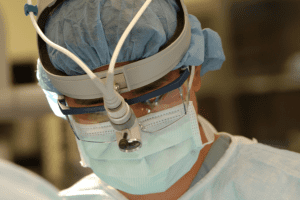Some patients have been told that one of the advantages of having surgery to remove the prostate (radical prostatectomy) is that it is the only true way to thoroughly review the pathology of the disease. At Chicago Prostate Cancer Center, we now know that Stereotactic Transperineal biopsy (STPB), sometimes referred to saturation biopsy, is very predictive of final pathology at time of radical prostatectomy. Below is an article we have written comparing results of the two procedures.
FINAL PATHOLOGY IN PATIENTS UNDERGOING radical prostatectomy: A CORRELATION STUDY BETWEEN stereotactic transperineal prostate biopsy AND RADICAL PROSTECTOMY
Dean J. Conterato, MD, Michelle H. Braccioforte, BS and Brian J. Moran, MD
Prostate Cancer Foundation of Chicago, Westmont, Illinois USA
Purpose: biopsy of the prostate is the most influential factor regarding prostate cancer treatment decisions. Stereotactic transperineal prostate biopsy (STPB) provides a more comprehensive assessment of cancer extent and location due to the large number of systematic biopsies. The purpose of this study was to analyze patients who underwent STPB prior to radical prostatectomy (RP), and to correlate the pathologic findings between the two procedures.
Materials and Methods: 1452 consecutive patients with continued rising total prostate specific antigen (PSA) having had a minimum of 1 prior benign transrectal extended systematic sextant prostate biopsy (range 1-10), underwent STPB at a single out-patient institution between 04/2004 and 11/2009. Median patient age, total PSA, prostate volume and number of specimens obtained were 63.11 years, 7.9 ng/ml, 45.1 cm3 and 38 specimens, respectively (Table 1). Specimens were obtained according to x, y, and z coordinates from equal octants with pathology reported accordingly. STPB yielded adenocarcinoma in 582/1452 (40%) patients. 103/582 (18%) patients with positive biopsy chose to undergo radical prostatectomy. radical prostatectomy and pathologic review was performed by multiple physicians at both community and university hospitals. Consent forms and pathologic reports were obtained in 85/103 (82.5%), of patients and reviewed.
Results: There was a 62/85 (73%) concordance rate between Gleason score reported on STPB and final prostatectomy specimen. Gleason score increased in 13/85 (15%) while downgrading was noted in 10/85 (12%) of patients. 18/85 (21%) patients had positive margins. There was a strong correlation of Gleason score and prostatectomy positive pathologic margins. In 81/85 (95%) patients, STPB accurately predicted location of malignancy with prostatectomy specimen.
Conclusions: STPB is efficacious for diagnosis of non-palpable, isoechoic occult prostate malignancy as demonstrated by the high concordance rate between biopsy and prostatectomy. It may also enhance research efforts regarding targeted therapy within the prostate gland. Furthermore, STPB may result in more reliable diagnosis with less undergrading compared to other biopsy techniques. Finally, histologic grade can suggest probability of positive pathologic margin. Considering this group of patients was previously undiagnosed and after radical prostatectomy, 21% were found to have positive margins, TRPB may be inadequate for a subset of patients. This information may influence the decision making process regarding appropriate treatment options.
Table 1: Patient Characteristics
| MEAN | MEDIAN | RANGE | |
| Age (years) | 62.84 | 63.11 | 40.7 – 85.1 |
| PSA (ng/ml) | 9.95 | 7.9 | 0.6 – 92.8 |
| Volume (cm3) | 49.56 | 45.1 | 5 – 163 |
| # Prior TRPB Sets | 1.54 | 1 | 1 – 10 |
| # Cores on prior TRPB | 12.68 | 12 | 4 – 56 |
| # Cores on STPB | 36 | 38 | 10 – 117 |
| # malignant Tissue Cores | 4.21 | 3 | 1 – 26 |
| Highest % Involvement | 26.8 | 15 | 1 – 100 |
Ongoing work and research is moving us closer to offering focal therapy for prostate cancer. Soon we intend to demonstrate that focal therapy in select patients is a reasonable alternative to whole gland treatment such as prostate brachytherapy or external beam radiation. Provided cancer control is equal to standard treatment options, there are additional benefits, mainly that of dramatically reduced toxicity for the patient and reduced cost. In conclusion, this approach is not new, as it has been proven in breast cancer treatment with lumpectomy and kidney cancer treatment with partial nephrectomy. At Chicago Prostate Cancer Center, we have favorable experience using focal therapy in the form of hemi-implant (half prostate implant). These are patients who have been previously biopsied with STPB, which maps the malignancy. We have then been able to design an implant for the same side of the prostate as the positive biopsy. Based on our biopsy information, patients have done well with no local failures and essentially no toxicity.


